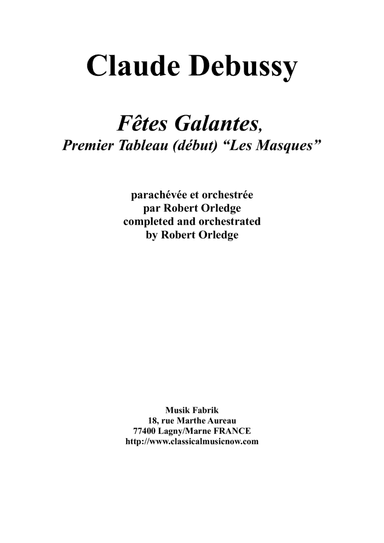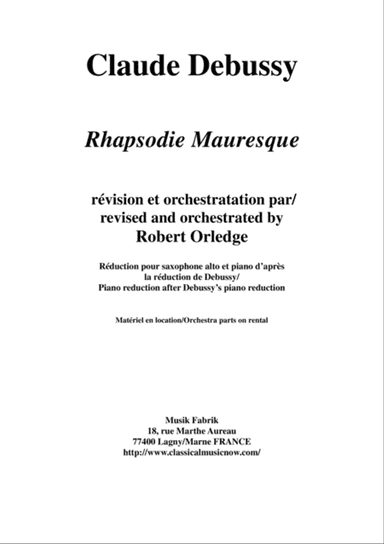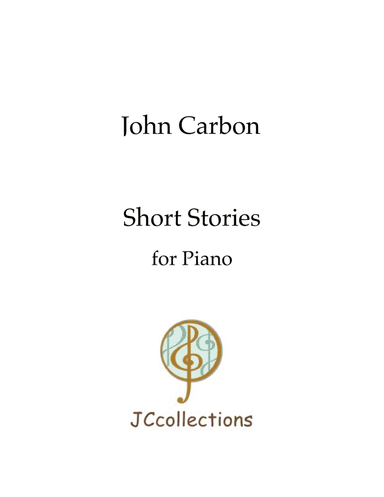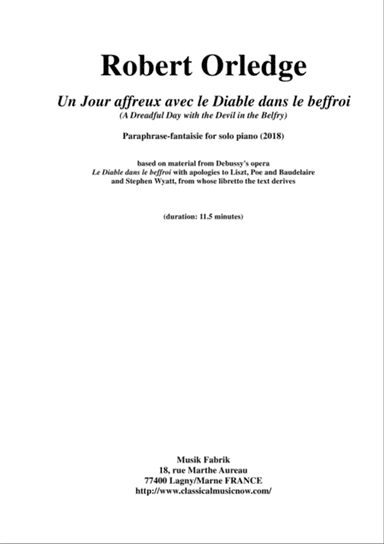Unavailable
Rapsodie for Alto Saxophone and Piano is currently unavailable
We can no longer provide this arrangement through Sheet Music Stores. The listing stays online so you can learn about the piece and explore alternatives.
Try these next steps
- Discover similar sheet music curated for you below.
- Search for “Rapsodie for Alto Saxophone and Piano” across our catalog.
About this arrangement
Alto Saxophone and Piano SKU: AP.36-M247191 Composed by Claude Debussy. Alto Saxophone, Solo with Piano, Solo and Piano; Performance Music Ensemble. Master Woodwind Series. Part(s). LudwigMasters Publications #36-M247191. Published by LudwigMasters Publications (AP.36-M247191). UPC: 660355086564. English.In 1901, American saxophonist Elise Hall commissioned works from numerous composers for her instrument, and among those composers was Claude Debussy (1862-1918). While Debussy took the money at the time, he was so focused on his opera Pelléas et Mélisande that he gave little thought to writing Hall's work. When suddenly Hall (whom Debussy referred to as the saxophone lady) and her teacher, French oboist Georges Longy, appeared in Paris unannounced and asked after the commission, the reluctant composer was prompted to finish most of the work in a rough score, at least. He followed this with a contract with his publisher to purchase the work, which resulted in his being paid twice for a work he had not yet fully completed yet. At this point, Debussy turned his attention to La Mer and never fully returned to this solo work which was eventually titled Rapsodie pour Orchestre et Saxophone, L. 98, although other titles were considered prior to this: Rapsodie Arabe; Rapsodie Mauresque pour Orchestre et Saxophone Obligé; Rapsodie Orientale; Esquisse d'uneRhapsodie Mauresque' pour Orchestre et Saxophone Principal. Debussy died in 1918 before he could put the finishing touches on the work or orchestrate it, so composer Jean Roger-Ducasse was given the Rapsodie by Debussy's second wife, Emma, to complete, along with all of her late husband's other remaining incomplete works. Roger-Ducasse completed the orchestration and the final piano reduction in 1918, and it is these versions with which everyone is now familiar. At this point, Elise Hall had gone completely deaf, so the premiere of the work fell to saxophonist Pierre Mayeur with the Société nationale de musique at Salle Gaveau in Paris on May 14, 1919, André Caplet conducting. These products are currently being prepared by a new publisher. While many items are ready and will ship on time, some others may see delays of several months.
Related sheet music


Rapsodie
claude debussy



Short Stories
john carbon

Rhapsodie Mauresque


Rhapsodie Mauresque

Rapsodie
paul creston


